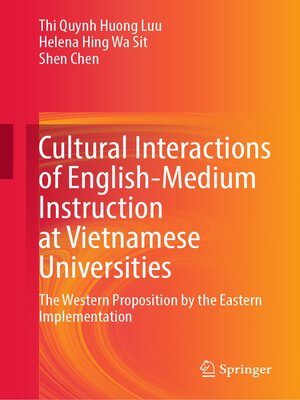Cultural Interactions of English-Medium Instruction at Vietnamese Universities
ebook ∣ The Western Proposition by the Eastern Implementation
By Thi Quynh Huong Luu

Sign up to save your library
With an OverDrive account, you can save your favorite libraries for at-a-glance information about availability. Find out more about OverDrive accounts.
Find this title in Libby, the library reading app by OverDrive.



Search for a digital library with this title
Title found at these libraries:
| Loading... |
This book presents a case study of English-Medium Instruction (EMI) implemented by universities in Vietnam, making valuable theoretical, empirical, and methodological contributions to the research in EMI which is currently a popular theme in the field of Higher Education. The importance of internationalization of higher education has been widely recognized by many countries all over the world. The spread of English as an international language has resulted in its crucial role in teaching and learning any disciplines. Globally, higher education in many non-English speaking countries has witnessed rapid expansion of (EMI) which was initiated in Europe, then to Asia and other continents which are featured with "Cultural Circles" spread in the world.
Although there are many publications with the same theme available today, this monograph is unique because it is the first time to examine EMI classroom interaction from the cultural perspective specifically rather than from linguistic or pedagogical perspectives. It is a pioneering attempt to discuss in depth about cultural issues relating to EMI, namely (1) the social-cultural context of EMI classes in higher education; (2) the cultural backgrounds of EMI teachers and learners; and (3) culture interactions between teachers and learners in EMI classrooms. In addition, both quantitative and qualitative methods are employed to collect data from teachers and learners. Finally, a context-based model of EMI is proposed based on findings of this research.
As a country within the Confucius Heritage Cultural Circle, Vietnam has been selected for this study because few studies to date are carried out in how EMI is culturally integrated to teaching and learning in the Vietnamese universities. This book is a joint effort by international academics, prepared for established scholars, researchers, educators, and research higher degree students who are interested in higher education, second and foreign language educationand EMI teacher training.






